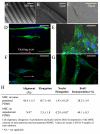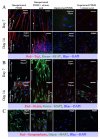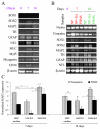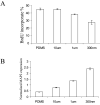Synthetic nanostructures inducing differentiation of human mesenchymal stem cells into neuronal lineage
- PMID: 17428465
- PMCID: PMC2038987
- DOI: 10.1016/j.yexcr.2007.02.031
Synthetic nanostructures inducing differentiation of human mesenchymal stem cells into neuronal lineage
Abstract
Human mesenchymal stem cells (hMSCs) have been shown to trans-differentiate into neuronal-like cells by culture in neuronal induction media, although the mechanism is not well understood. Topography can also influence cellular responses including enhanced differentiation of progenitor cells. As extracellular matrix (ECM) in vivo comprises topography in the nanoscale, we hypothesize that nanotopography could influence stem cell differentiation into specific non-default pathways, such as transdifferentiation of hMSCs. Differentiation and proliferation of hMSCs were studied on nanogratings of 350 nm width. Cytoskeleton and nuclei of hMSCs were aligned and elongated along the nanogratings. Gene profiling and immunostaining showed significant up-regulation of neuronal markers such as microtubule-associated protein 2 (MAP2) compared to unpatterned and micropatterned controls. The combination of nanotopography and biochemical cues such as retinoic acid further enhanced the up-regulation of neuronal marker expressions, but nanotopography showed a stronger effect compared to retinoic acid alone on unpatterned surface. This study demonstrated the significance of nanotopography in directing differentiation of adult stem cells.
Figures




References
-
- Dalby MJ, McCloy D, Robertson M, Agheli H, Sutherland D, Affrossman S, Oreffo RO. Osteoprogenitor response to semi-ordered and random nanotopographies. Biomaterials. 2006;27:2980–2987. - PubMed
-
- Silva GA, Czeisler C, Niece KL, Beniash E, Harrington DA, Kessler JA, Stupp SI. Selective differentiation of neural progenitor cells by high-epitope density nanofibers. Science. 2004;303:1352–1355. - PubMed
-
- Curtis A, Wilkinson C. Nantotechniques and approaches in biotechnology. Trends Biotechnol. 2001;19:97–101. - PubMed
-
- Curtis AS, Wilkinson CD. Reactions of cells to topography. J Biomater Sci Polym Ed. 1998;9:1313–1329. - PubMed
-
- Wilkinson CDW. Nanostructures in Biology. Microelectron. Eng. 1995;27:61–65.
Publication types
MeSH terms
Substances
Grants and funding
LinkOut - more resources
Full Text Sources
Other Literature Sources
Research Materials

